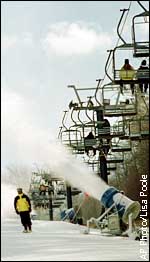 Let it snow or make it snow Let it snow or make it snow
by Bryan Thomas, Winter X Games lead researcher
As of November 1999
Mount Snow averages almost 157 inches of natural snow annually. In a good year, Crested Butte, Colo., (site of the '98 & '99 Winter X Games) can see twice that amount. Looking back on the first few bare and brown days of the 1999 Winter X competition in Crested Butte, the move to the often snow-starved East seemed like a p-tex salesman's dream come true.
|  | | Snowmaking has long been an Eastern staple. |
But what Mount Snow lacks in natural snowfall, it more than makes up for with its highly-rated snowmaking operation. The Mount Snow system dwarfs the Crested Butte operation in acreage, equipment, and length of snowmaking season. Crested Butte's general snowmaking philosophy is geared toward building up the snow base in the early part of the season, then hoping Mother Nature will grab the reins by early January. Mount Snow can't afford to wait on Mother Nature. The resort employs 40 snowmakers from November through March, many of whom put in 50 hours a week during the peak season.
The Mount Snow snowmaking system covers 498 skiable acres, stretching over almost 38 miles of trails. In all, the man-made snow operation can blanket 85 percent of the resort in the white stuff. The mountain is equipped with more than 1500 snowmaking guns and 1700 hydrants. Running full tilt, the system can pump 9000 gallons of water per minute.
Mount Snow has pledged to devote five full-time snowmakers to the Winter X Games effort, and has also installed a number of new hydrants and towers to meet specific venue needs.
The operation's central nervous system is located in the mountain's maintenance building, where hydrants and pumps are monitored and plans of attack are drawn. "Some mountains are fully automated," says snowmaking manager Randy Barrows, who has been making snow for 20 years (17 years at Mount Snow). "But we could never run that way. We are usually staffed 24 hours a day, except for when it's too warm or it's snowing."
A snowmaking shift can last up to 12 hours and consists of making several runs. "A run will take a minimum of an hour and a half and can last up to three hours," says Barrows. "One or two guys will get dropped off by a snowmobile on a trail and will then have to check the guns on that trail to make sure they're not frozen. They also have take the wind into account and make sure we're blowing snow to the right spots."
Temperature is the most important ingredient in the snowmaking equation. "When it's 28 degrees [Fahrenheit], we can blow about two inches of snow an hour," says Barrows. "At zero degrees, we can get three or four feet in an hour... In the past few years we've become a lot more concerned about the quality of the snow. We used to say, 'If it's white, it's right,' even if that meant slushy snow. Now we don't like to run unless it's cold enough to make good snow. However - we couldn't be too picky last year because it was just a bad snow year."
Barrows says that he'd rather ski on man-made snow than natural snow. "And I bet 99 percent of all snowmakers would say the same thing," he claims. "I call it styrofoam snow. It's a little 'grippier' and softer on the knees."
Because snowmakers necessarily work in sub-freezing temperatures (often at night) and constantly handle wet hoses and pipes, they layer themselves in Gore-Tex shells and heavy-duty waterproof boots. "Sometimes they wear crampons - especially if they're out there by themselves on some steep stuff," says Barrows. Ripcord, the double black diamond with a 37-degree pitch, rated one of the steepest trails in the East by Skiing Magazine, is the type of trail that occasionally warrants lacing up some protective gear. "Whenever we ask for volunteers to do Ripcord, not too many rookie hands go up," laughs Barrows.
Barrows took a weather seminar this fall given by Lou McNally, meteorologist at WMTW, the ABC affiliate in Portland, Maine. "He said we're in for a good winter. After last winter, I hope he's right."
|
